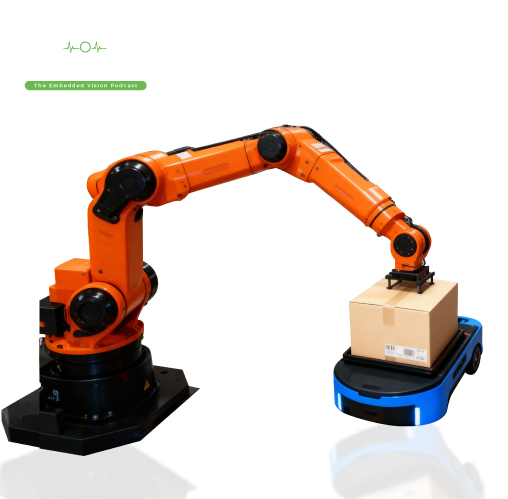Welcome to Vision Vitals, e-con Systems' exciting new podcast.
Today, we focus on a key innovation powering warehouse automation, namely multi-camera systems.
To explain how multiple cameras deliver full environmental awareness for warehouse robots, we're joined once again by our expert guest.
Always a pleasure. Multi-camera setups are one of the most impactful technologies shaping warehouse robotics right now. They bring 360° vision, intelligence, spatial awareness, and safety into one unified system.
Speaker:
A single camera provides only a limited field of view. For warehouse robots operating in large, crowded environments, that's not enough. They need to perceive obstacles, pallets, and people approaching from different directions.
Multi-camera systems solve that problem. With cameras placed at strategic angles such as front, rear, and sides, robots can build a 360-degree understanding of their surroundings.
That awareness enables safe movement, accurate navigation, and efficient task execution, whether it's transporting materials, loading shelves, or docking at charging stations.
Host:
Is the idea to give robots vision similar to human peripheral awareness?
Speaker:
Exactly. Multiple cameras expand spatial coverage and reduce blind zones. The robot can detect obstacles and people from all sides, improving safety.
They also help improve localization. By tracking features from various angles, the robot's SLAM algorithm gets more reference points, which strengthens mapping accuracy.
In high-traffic warehouses, that precision helps robots plan smoother routes and avoid collisions with both humans and machines.
Host:
Then, how do multi-camera systems influence depth perception and distance measurement?
Speaker:
Depth perception improves dramatically when two or more cameras capture the exact same scene from multiple viewpoints. Through stereo vision, the system measures disparity, the difference between corresponding pixels, to estimate depth.
That empowers the robot to calculate distances to objects, determine shape, and estimate volume. e-con Systems offers synchronized camera setups with low-latency streaming for such applications.
When the data is processed in real time, warehouse robots can identify moving objects, detect height variations, and navigate complex layouts more confidently.
Host:
So, are multi-camera systems used only for navigation?
Speaker:
Not at all. They also handle secondary tasks like barcode recognition, inventory monitoring, and aisle inspection.
Front cameras focus on path planning and obstacle avoidance. Side cameras ensure safety near aisles and shelves. Rear cameras assist during reverse movement and docking.
Using cameras with specific fields of view and sensor types means that warehouse robots can manage a range of operations with accuracy.
Host:
What about synchronization? How do all those cameras work together in real time?
Speaker:
Synchronization is vital. Multi-camera systems need perfect timing so that frames align across feeds. e-con Systems uses interfaces like GMSL2, which support long-distance transmission and high-speed data transfer without interference.
It ensures all video streams reach the central processor simultaneously. When aligned, the system builds a consistent visual model of the environment.
The alignment also helps prevent latency issues that could otherwise cause misjudgement in obstacle detection or motion planning.
Host:
What are the main advantages of using synchronized multi-camera setups in warehouse robots?
Speaker:
Three stand out.
- • First, improved safety. Continuous 360° visual coverage ensures the robot detects people or forklifts from every direction.
- • Second, higher efficiency. With full visual awareness, the robot can plan shorter paths and avoid unnecessary stops.
- • Third, more flexibility. Developers can choose camera placements and focal lengths based on warehouse layout or task type.
e-con Systems supports modular architectures where multiple cameras are tuned together through validated drivers and ISPs, ensuring stable synchronization across all feeds.
Host:
Since lighting can vary inside warehouses, how do cameras adapt to such conditions?
Speaker:
Warehouse environments have uneven lighting, bright loading docks and dim storage aisles. Cameras must adapt instantly to those changes.
HDR sensors help maintain detail in both bright and dark regions, while low-noise performance ensures clarity in shadows. Cameras like the STURDeCAM31 or See3CAM_CU135 excel in such scenarios, offering consistent exposure and color balance.
When tuned through e-con Systems' ISP pipeline, the image feed stays reliable for object detection even when lighting fluctuates during robot movement.
Host:
Are there any hardware challenges when integrating several cameras into one robot?
Speaker:
Yes, there are mechanical, electrical, and thermal factors to manage. Multi-camera setups require stable mounts, shielded cabling, and proper synchronization circuitry.
Interfaces like GMSL2 simplify integration since they carry both power and data over a single coaxial cable. That reduces wiring complexity and ensures clean signal transmission.
The cameras themselves are compact and rugged, with IP-rated designs suitable for continuous operation in dusty or vibrating conditions.
Host:
Does a multi-camera system affect processing load on the robot's compute platform?
Speaker:
Yes, it does increase data volume, which means more processing. That's why optimized hardware-software coordination is crucial.
e-con Systems validates its cameras for platforms such as NVIDIA Jetson AGX Orin, ensuring efficient frame synchronization and parallel processing. The TintE ISP pipeline handles image corrections, freeing compute resources for AI and decision-making.
That results in smoother navigation and quicker responses even when multiple streams run simultaneously.
Host:
Can you share examples of how warehouse robots benefit from full 360-degree vision?
Speaker
A materials-handling robot can detect workers approaching from blind spots and stop safely. Inventory robots can scan shelves from different sides to capture missing or misplaced items.
Docking robots use front and rear feeds to align precisely with charging stations. Path-following robots rely on side cameras to maintain lane accuracy and avoid collisions with pallets or other vehicles.
Those examples show how 360-degree awareness directly improves uptime, safety, and operational reliability inside warehouses.
Host:
Sounds like multi-camera systems are becoming standard for next-generation warehouse robots. Do I have that right?
Speaker:
You're absolutely right. They bridge the gap between traditional vision and full spatial perception. With advancements in synchronized streaming, sensor tuning, and embedded processing, multi-camera systems are setting a new benchmark for intelligent navigation.
They make warehouse robots more aware, safer to operate around people, and better equipped to handle dynamic environments.
Host:
That's certainly a strong note to close on!
Now, we've seen how multi-camera systems deliver 360-degree awareness for warehouse robots, improving safety, navigation, and efficiency across every operation.
To learn more about e-con Systems' range of synchronized multi-camera solutions for AMRs, visit www.e-consystems.com.
Stay connected as we continue with more insights into state-of-the-art vision technology that is helping drive the future.
Close Full Transcript



 Mr. Thomas Yoon
Mr. Thomas Yoon +82-10-5380-0313
+82-10-5380-0313










